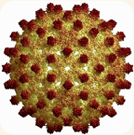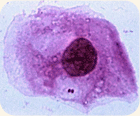|
Immunizations
 Overview
Disease prevention is the key to public health. It is always better to prevent a disease than to treat it. Vaccines, or immunizations, help prevent infectious diseases, save lives, and are responsible for the control of many infectious diseases that were once common in this country. Among these diseases are polio, measles, diphtheria, pertussis (whooping cough), rubella (German measles), mumps, and tetanus. We offer immunizations for adults and children older than 4 years of age.
Your immune system helps your body fight germs by producing substances (called antibodies) to combat them. Once it does, the immune system "remembers" the germ and can fight it again. Vaccines contain germs that have been killed or weakened. When given to a healthy person, the vaccine triggers the immune system to respond and thus build immunity. Before vaccines, people became immune only by actually getting a disease and surviving it. Vaccines are an easier and less risky way to become immune.  Hepatitis A
Hepatitis A is a contagious liver disease that results from infection with the hepatitis A virus. It can range in severity from a mild illness lasting a few weeks to a severe illness lasting several months. Hepatitis A is usually spread when a person ingests fecal matter— even in microscopic amounts— from contact with contaminated objects, food, or drinks. The best way to prevent hepatitis A is by getting vaccinated.
Although anyone can get hepatitis A, certain groups of people are at higher risk in the United States, such as those who travel to or live in countries where hepatitis A is common, are men who have sexual contact with other men, use illegal drugs, have clotting-factor disorders, and are intimate someone who has hepatitis A. Hepatitis A vaccination is recommended for all children, for travelers to certain countries, and people at high risk for infection with the virus. Frequent handwashing with soap and warm water after using the bathroom, changing a diaper, or before preparing food can help prevent the spread of hepatitis A.  Hepatitis B
Hepatitis B is a contagious liver disease that results from infection with the hepatitis B virus. Hepatitis B can be either acute or chronic. Acute hepatitis B virus infection is a short-term illness that occurs within the first 6 months after someone is exposed to the hepatitis B virus. Acute infection can, but does not always, lead to chronic infection. Chronic hepatitis B virus infection is a long-term illness that occurs when the hepatitis B virus remains in a person's body.
The virus is spread when blood, semen, or other body fluid infected with the hepatitis B virus enters the body of a person who is not infected. People can become infected with the virus during activities such as birth (spread from an infected mother to her baby), sex with an infected partner, sharing razors or toothbrushes with an infected person, direct contact with the blood or open sores of an infected person, and exposure to blood from needlesticks or other sharp instruments. Hepatitis B vaccination is recommended for all infants, all children and adolescents younger than 19 years of age who have not been vaccinated, men who have sexual contact with other men, sexually active people who have multiple partners or an infected partner, people with end-stage renal disease, people with chronic liver disease, people with HIV infection, workers at risk for exposure to blood or blood-contaminated body fluids on the job, and travelers to regions with moderate or high rates of hepatitis B.  Td and Tdap
Children 6 years of age and younger routinely receive tetanus, diphtheria, and pertussis. However, older children, adolescents, and adults need protection from these diseases as well. Td (tetanus and diphtheria) and Tdap (tetanus, diphtheria, and pertussis) vaccines provide that protection. Td vaccine protects against tetanus and diphtheria and has been used for many years. Tdap was licensed in 2005 and is the first vaccine for adolescents and adults that protects against all three diseases.
These three diseases are all caused by bacteria. Diphtheria and pertussis are spread from person to person. Tetanus enters the body through cuts, scratches, or wounds.
These vaccines can be used as catch-up for people who did not get all their doses of DTaP or DTP when they were children, as a booster dose every 10 years, and for protection against tetanus infection after a wound. Adults under 65 who expect to have close contact with an infant younger than 12 months of age (including women who may become pregnant) should get a dose of Tdap, as well as healthcare workers who have direct patient contact. New mothers who have never gotten Tdap should get a dose as soon as possible after delivery. If vaccination is needed during pregnancy, Td is usually preferred over Tdap.  Meningitis
Meningitis is a disease caused by the inflammation of the protective membranes covering the brain and spinal cord known as the meninges. The inflammation is usually caused by an infection of the fluid surrounding the brain and spinal cord. Meningitis may develop in response to a number of causes, usually bacteria or viruses, but meningitis can also be caused by physical injury, cancer, or certain drugs.
About 10% of infected people die from the disease. In non-fatal cases, those affected experience long-term disabilities, such as brain damage, loss of limb, or deafness. Preventing the disease through the use of meningococcal vaccine is important. Although anyone can get meningitis, pre-teens and adolescents, college freshmen who live in dormitories and travelers to countries where meningitis is always present are at an increased risk. The most effective way to protect you and your child against certain types of meningitis is to complete the childhood meningitis vaccine schedule. The risk of meningitis increases by not following the recommended vaccine schedule. Other factors that can increase your risk of meningitis include young age (viral meningitis occurs mostly in children younger than age 5), community setting (close living quarters), pregnancy, working with animals, and a weakened immune system.  HPV
Genital HPV infection is a sexually transmitted disease (STD) that is caused by human papillomavirus (HPV). Human papillomavirus is the name of a group of viruses that includes more than 100 different strains or types. More than 30 of these viruses are sexually transmitted, and they can infect the genital area of men and women, including the skin of the penis, vulva (area outside the vagina), or anus, and the linings of the vagina, cervix, or rectum.
The HPV vaccine can protect females from the 4 types of HPV that cause most cervical cancers and genital warts. The vaccine is recommended for 11- and 12-year-old girls. It is also recommended for girls and women of ages 13–26 who have not yet been vaccinated or completed the vaccine series. It is possible that vaccinating males will have health benefits for them by preventing genital warts and rare cancers, such as penile and anal cancer. Studies are now being done to find out if the vaccine works to prevent HPV infection and disease in males. The vaccine does not protect against all types of HPV, so it will not prevent all cases of cervical cancer. About 30% of cervical cancers will not be prevented by the vaccine; therefore, it will be important for women to continue getting screened for cervical cancer through regular Pap tests. Women who get the vaccine after becoming sexually active may not get the full benefits if they have already acquired HPV.  MMR
The MMR vaccine is administered for immunization against measles, mumps, and rubella (also called German measles). The first of 2 doses is generally given to children at 12–15 months of age, with a second dose before starting school (at 4–6 years of age). While these are the recommended ages, children can get the second dose at any age, as long as it is at least 28 days after the first dose.
Any person can catch these serious diseases by being around someone who has them. They spread from person to person through the air. Most children who get their MMR shots will not get these diseases, and many more would get them if we stopped vaccinating. Some adults should also get MMR vaccine; generally, anyone 18 years of age or older who was born after 1956 should get at least one dose of MMR vaccine, unless they can show that they have had either the vaccines or the diseases.
 Varicella (Chickenpox)
The chickenpox vaccine is the best way to prevent chickenpox and reduce the risk for exposure in the community for persons unable to be vaccinated. About 9 of every 10 people who are vaccinated are completely protected from chickenpox. In addition, the vaccine almost always prevents severe disease. If a vaccinated person does get chickenpox, it is usually a very mild case, lasting only a few days and involving fewer skin lesions, mild or no fever, and few other symptoms.
All healthy children 12 months–12 years of age should have two doses of chickenpox vaccine, administered at least 3 months apart. People 13 years of age and older who do not have evidence of immunity should get two doses of the vaccine 4–8 weeks apart. Compared to children, adolescents and adults are at increased risk for more severe disease from chickenpox. Adults without immunity who might be at increased risk for exposure or transmission should receive special consideration for vaccination. These include health care providers, people who live or work in environments in which chickenpox transmission is likely, non-pregnant women of childbearing age (women should avoid pregnancy for 1 month following each vaccine dose), and international travelers. | |||